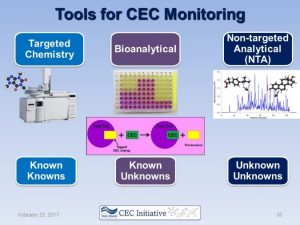SCCWRP-developed CEC monitoring framework highlighted at State Water Board meeting

State Water Board members explored multiple approaches being taken to improve CEC monitoring statewide during an informational meeting agenda item in February.
Some of the presentations they heard at the meeting highlighted an adaptive management strategy developed by SCCWRP to evaluate the risks of CECs in aquatic systems.
Two Regional Water Quality Control Boards – North Coast and Los Angeles – discussed the pilot studies they’re undertaking with SCCWRP in their respective regions to evaluate the utility of this CEC monitoring strategy.
Initially unveiled by SCCWRP in 2015, the risk-based adaptive management strategy is intended to provide water-quality managers with an efficient, cost-effective way to zero in on the CECs that pose the greatest potential risks to humans and ecosystems.
Through the pilot studies, water-quality managers will gain insights into whether the monitoring strategy could be effectively applied to aquatic systems across California, particularly water bodies with significant water-quality impairments.
During the February 22 informational agenda item, State Water Board staff also briefed board members on the underlying research that SCCWRP and its partners are conducting to refine the scientific tools that are foundational to the strategy.
SCCWRP’s CEC monitoring strategy focuses on two emerging technologies that SCCWRP has been working on with collaborators for nearly a decade:
» Bioanalytical screening assays, in which engineered cell lines are exposed to water samples so that a potential biological response can be measured
» Non-targeted chemical analysis, in which chromatography and rapid-scan mass spectrometry are used to separate and identify chemicals in complex mixtures based on physical and chemical properties
These technologies have the potential to enable water-quality managers to screen a much larger universe of CECs than they can with existing, chemical-specific monitoring methods. Incorporation of these CEC screening tools could streamline existing monitoring workflows and make more efficient use of labor-intensive, time-consuming traditional methods, such as whole-organism toxicity testing and targeted chemical analyses.
In May, SCCWRP is scheduled to brief regulators and dischargers from the Central Valley and Delta regions on the CEC monitoring strategy during a two-day workshop in Sacramento.
And later this year, SCCWRP will reassemble an expert advisory panel that will help SCCWRP vet and help shape research to improve CEC monitoring in recycled water. SCCWRP assembled the initial statewide panel in 2009.
For more information, contact Dr. Keith Maruya.
More news related to: Bioanalytical Cell Screening Assays, Emerging Contaminants, Top News